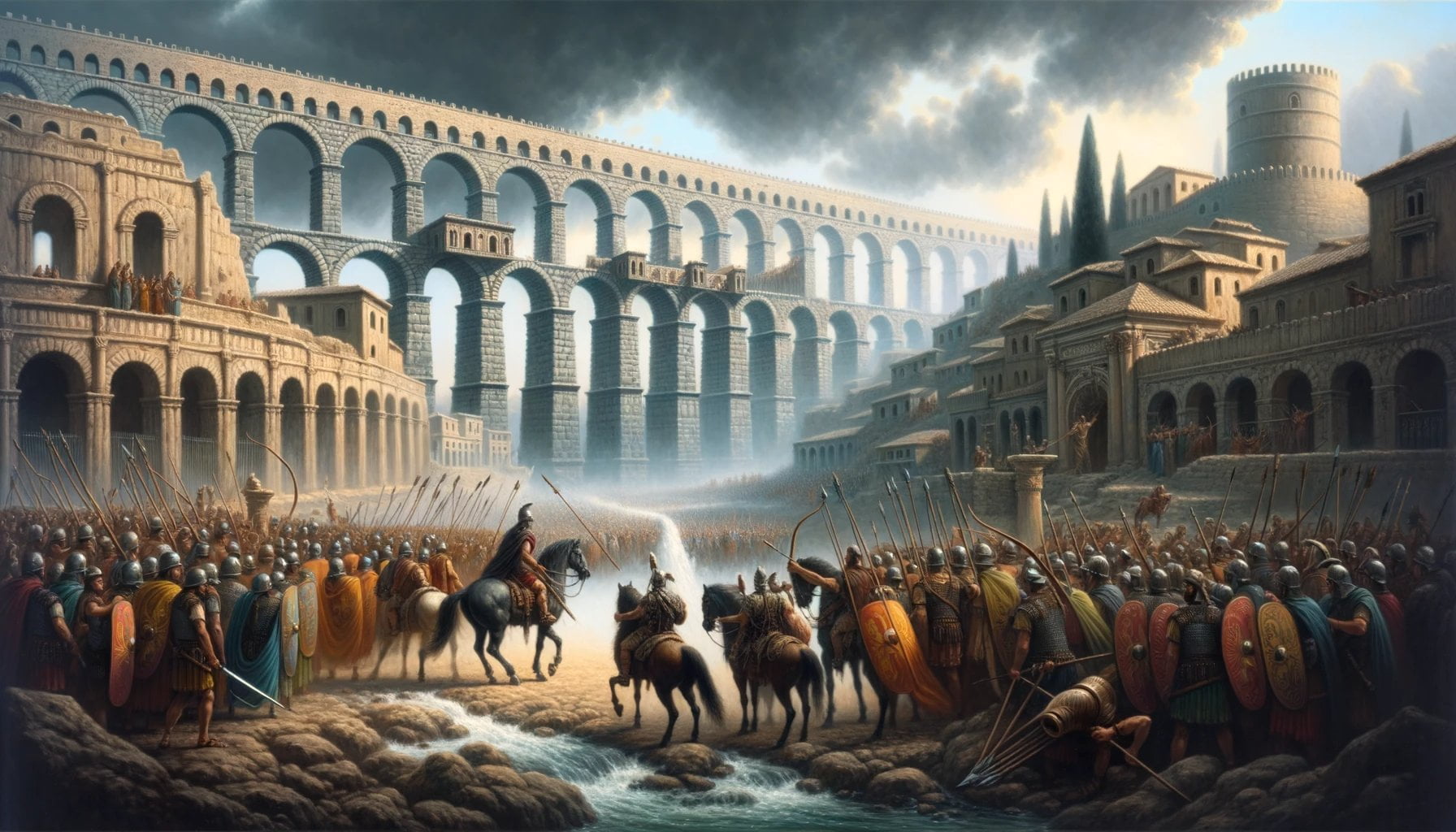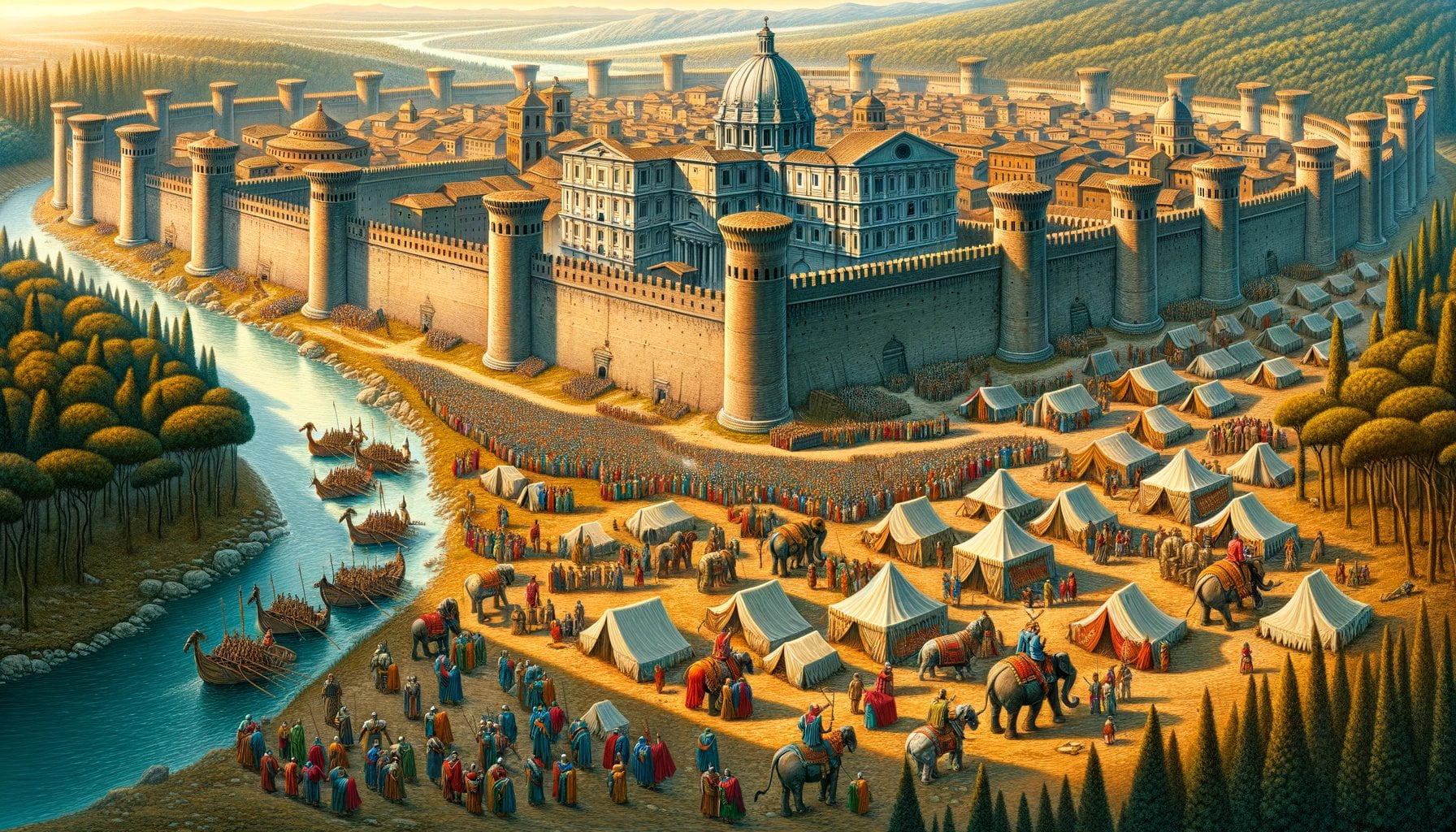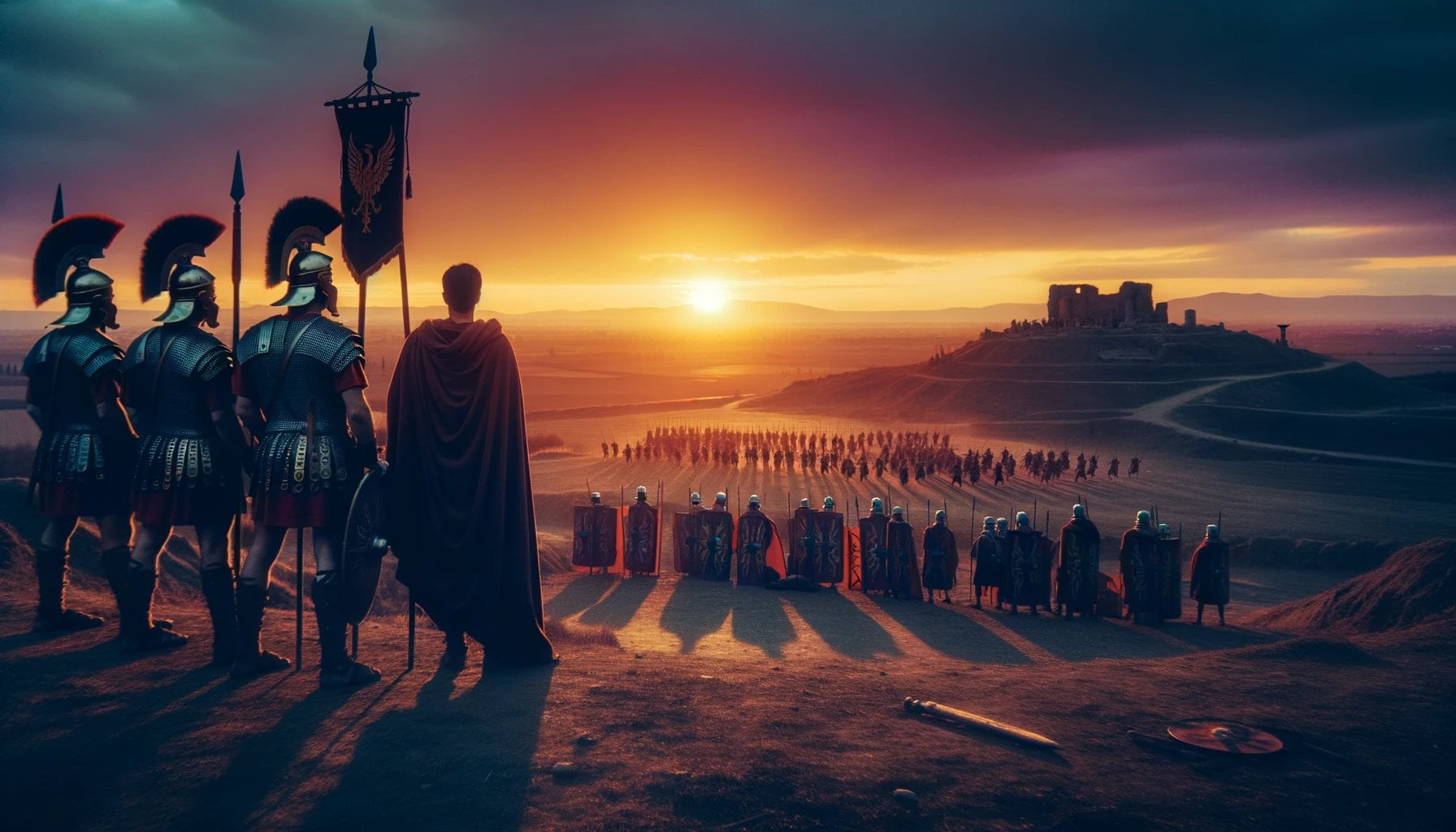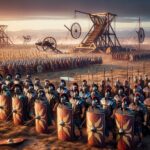Welcome to a journey through the riveting world of the invaders of Ancient Rome. In this exploration of history, we will delve into the motivations, strategies, and profound impact these external forces had on the mighty Roman Empire. From the barbarian hordes to ambitious conquerors, we will uncover the remarkable tales of those who challenged Rome’s dominance. Prepare to be captivated as we unveil the intriguing secrets and reveal the full scope of Rome’s interactions with its invaders throughout the ages.

Key Takeaways:
- The Goths, Germanic invaders from present-day Sweden, were among the many tribes that invaded Ancient Rome.
- Other Germanic tribes such as the Vandals, Burgundians, and Gepidae also invaded Rome.
- The Huns’ invasion of Europe caused migration and led to the Barbarian invasions of Rome.
- These invasions disrupted and weakened the Roman Empire, contributing to its decline.
- The Western Roman Empire began to disintegrate in the early 5th century.
- Assimilation of Germanic peoples within the empire led to internal conflicts and disloyalty.
- The invasions of the Roman Empire were particularly violent in the West.
Invaders of Ancient Rome
Throughout history, the mighty Roman Empire faced numerous challenges from invaders that sought to conquer its vast territories and undermine its power. These invasions not only tested the military might of Rome but also had lasting impacts on its social, political, and economic landscape. In this article, we will delve into the motivations, strategies, and impact of the invaders who threatened ancient Rome.
The Gothic Menace
The Goths, a Germanic tribe hailing from what is now known as Sweden, were among the first invaders to ravage the Roman Empire. Fueled by a desire for wealth and territory, they launched vicious raids upon Roman provinces, striking fear into the hearts of the Roman citizens. But what drove these warriors to venture so far from their homeland?
The Goths, like many others, were forced to migrate due to the invasion of the fearsome Huns. Seeking refuge and a new place to call home, they found themselves on a collision course with the Roman Empire. Their lightning-fast raids and guerrilla warfare tactics kept the Romans on their toes, as they struggled to combat this new and formidable threat.
The Cascade of Germanic Tribes
Following in the footsteps of the Goths, other Germanic tribes emerged from the shadows, ready to stake their claim within the Roman territories. The Vandals, Burgundians, and Gepidae all sought to exploit the weakening Empire for their own gain. These tribes, driven by the allure of Roman riches and opportunities, struck at the heart of Rome’s vulnerability.
As more and more Germanic tribes descended upon the Roman Empire, the once-mighty state began to crumble under the weight of constant invasions and internal conflicts. The assimilation of Germanic peoples within the Empire also contributed to these internal divisions, as loyalties became blurred and tensions ran high.
The Fallout and Disintegration
The invasions and civil wars brought on by these Germanic tribes and the Huns’ migration created significant disruptions and weaknesses within the Roman Empire. The Western Roman Empire, in particular, suffered greatly, with its disintegration becoming evident in the early 5th century.
As invaders plundered the once-great cities of Rome, the empire’s decline became undeniable. The violence and destruction inflicted upon the Western Roman Empire left an indelible mark on its history, highlighting the vulnerabilities of even the most powerful of empires.
Unveiling the Motives
What motivated these invaders to relentlessly assail the Roman Empire? The answer lies in the allure of wealth, power, and opportunity. The Roman Empire, with its vast resources and well-organized infrastructure, presented an irresistible target for those seeking to improve their own fortunes.
The collapse of the Western Roman Empire also served as a cautionary tale of the dangers of internal division and external threats. As the empire assimilated various peoples, it inadvertently sowed the seeds of its own downfall. The disloyalty and internal conflicts that emerged within its borders weakened its ability to defend against invaders and ultimately contributed to its demise.
Conclusion
The invaders of ancient Rome, whether the Goths, Vandals, or other Germanic tribes, played a significant role in the decline of the mighty Roman Empire. Motivated by the promise of wealth and power, these invaders struck at the heart of Rome’s vulnerabilities, exploiting its internal divisions and weakened defenses.
The Roman Empire, once an unrivaled force, faced formidable challenges from external forces, revealing the complex interactions and dynamics between invaders and the empire throughout history. By studying their motivations, strategies, and impact, we gain a deeper understanding of the challenges that Rome faced and the factors that ultimately led to its decline. Join us as we continue to unravel the mysteries of the invaders of ancient Rome and shed light on the pivotal events that shaped the course of history.
In ancient Rome, poetry was a cherished art form that captured the essence of the era. Explore the rich and fascinating world of poetry in ancient Rome by clicking here: poetry in ancient rome.
Imagine stepping back in time and wandering through the quaint and picturesque villages of ancient Rome. Click here to discover the hidden charm of villages in ancient Rome: villages in ancient rome.
Get ready for an adrenaline rush as you dive into the thrilling games played in ancient Rome. Click here to experience the excitement of games in ancient Rome: games in ancient rome.
The role of a praetor in ancient Rome was vital, influencing the judiciary and governance. Click here to learn more about the fascinating life of a praetor in ancient Rome: praetor ancient rome.
Witness the epic battles and heroic feats of ancient Rome by clicking here: ancient battle rome. Immerse yourself in the awe-inspiring history of ancient Rome.
Ancient Rome was not only known for its grandeur but also for its vibrant and mesmerizing dance forms. Click here to discover the enchanting world of ancient Rome dance: ancient rome dance. Let the rhythms and movements transport you to a bygone era.
The Cultural Clashes Between Rome and the Invaders
The invasions faced by ancient Rome were not merely military actions, but encounters that led to profound cultural clashes and transformations. As the mighty Roman Empire expanded, it inevitably came into contact with external forces that sought to exploit its vulnerability and challenge its authority. These clashes, often marked by violence and destruction, revealed the intricate dynamics between Rome and the invaders, shedding light on the motivations, strategies, and impact of these historical events.
Understanding the Motivations
The invaders, such as the Goths, Vandals, Burgundians, Gepidae, and others, were driven by various motivations that stemmed from the allure of wealth, power, territory, and opportunities presented by a weakened Roman Empire. For instance, the Goths launched raids on Roman provinces, their desire for wealth and territory fueling their aggression. Meanwhile, the arrival of the Huns and the subsequent migration of various Germanic tribes added another layer of complexity to the situation. The invaders saw an opportunity to exploit the Romans’ vulnerability and gain advantages for themselves.
Strategies and Tactics
The cultural clashes between Rome and the invaders were not only defined by physical confrontations but also by the strategic maneuvers employed by both sides. The Roman Empire had developed a sophisticated system of institutionalized violence, which allowed it to repel and defeat many invaders. The invaders, on the other hand, had to adapt their tactics to confront a highly organized and disciplined military force. They utilized guerrilla warfare, raiding, and hit-and-run tactics, taking advantage of the Romans’ weaknesses and vulnerabilities.
Impact on Rome
The interactions between Rome and the invaders had a profound impact on both sides. The constant invasions and internal conflicts weakened the Roman Empire, undermining its stability and contributing to its eventual disintegration. The invasions created disruptions and vulnerabilities within the empire, particularly in the Western Roman Empire, which bore the brunt of the attacks. The cultural clashes and assimilation of various peoples also weakened Rome’s ability to defend against invaders, as internal division further eroded the empire’s strength.
The influence of the invaders was strongest in regions where the Romans had the least impact. Central Europe, in particular, experienced an influx of barbarian migrations and invasions that reshaped the cultural landscape. The invaders left lasting imprints on the social, political, and economic fabric of the regions they conquered or settled in, shaping the course of history in these areas.
Key Takeaways:
- The invasions of ancient Rome were not just military conflicts but clashes of cultures and civilizations.
- The motivations of the invaders ranged from a desire for wealth and territory to taking advantage of Rome’s vulnerability.
- Rome employed institutionalized violence, while the invaders utilized guerrilla warfare and hit-and-run tactics.
- The invasions weakened the Roman Empire, contributing to its eventual disintegration.
- The impact of the invaders was strongest in regions where Roman influence was minimal.
- The cultural clashes between Rome and the invaders left lasting imprints on the regions affected.
Sources:
- Encyclopedia Britannica: Barbarian Invasions
- Ancient Origins: Late Antiquity and the Fall of Rome
The Political Implications of the Invasions on the Roman Empire
The invasions of ancient Rome by Germanic tribes brought about significant political implications that eventually led to the fall of the Western Roman Empire. In this article, we will explore the motivations, strategies, and impacts of these invasions, shedding light on the formidable challenges that Rome faced from external forces. By understanding the political implications of these invasions, we can gain insights into the complex dynamics that shaped the fate of the Roman Empire.
Key Takeaways:
– The invasions of Germanic tribes and the migrations of Slavs were formative elements of the distribution of peoples in modern Europe.
– Economic and social crises, government corruption, political instability, and military overspending were some of the impacts of the invasions on the Roman Empire.
– The resettlement of Germanic soldiers and families among the existing Roman population caused changes in culture in certain areas.
– The fall of the Roman Empire created a political void that the church eventually entered, leaving a lasting legacy in art and cultural history.
Impact on Roman Politics and Governance:
The invasions of the Germanic tribes created significant political challenges for the Roman Empire. The constant threat of invasion and the need to allocate resources for defense put immense strain on imperial administration. As a result, the Roman government became increasingly corrupt and inefficient, unable to effectively manage the vast territories under its control.
With the empire focused on external threats, internal conflicts and divisions within the ruling class grew. This weakened the unity and stability of the Roman Empire, providing an opportunity for ambitious individuals to seize power and exacerbating the decline of centralized authority.
Social and Cultural Transformations:
The invasions of ancient Rome facilitated the resettlement of Germanic tribes within the empire’s borders. As these tribes merged with the existing Roman population, cultural clashes and transformations occurred. The invading tribes brought with them their own languages, customs, and traditions, which influenced and altered the cultural landscape of certain regions.
This assimilation of cultures ultimately contributed to the decline of Roman cultural dominance and paved the way for the emergence of new European identities and civilizations.
The Political Void and the Influence of the Church:
The fall of the Western Roman Empire left a political void that was eventually filled by the Christian church. As the imperial government lost its power and influence, the church, with its organizational structure and religious authority, stepped in to fill the leadership vacuum.
The church’s involvement in political affairs and its ability to provide a sense of stability and order helped shape the legacy of the Roman Empire in art, architecture, and cultural history. The influence of the church on subsequent European societies can be traced back to this pivotal moment in history.
Conclusion:
The invasions of ancient Rome by Germanic tribes had far-reaching political implications that contributed to the fall of the Western Roman Empire. Economic and social crises, government corruption, and political instability weakened the empire, while the resettlement of Germanic tribes led to cultural transformations. The political void created by the collapse of the empire allowed the church to emerge as a new governing force, leaving a lasting impact on European history.
The Lasting Legacy of the Invaders on Ancient Rome
The invaders of ancient Rome left a lasting legacy that shaped the course of history. From Roman achievements and cultural practices to the influence on subsequent civilizations, their impact cannot be understated. Let’s delve into the motivations, strategies, and overall impact of these formidable invaders.
Motivations of the Invaders
The invaders, such as the Goths, Vandals, and other Germanic tribes, were driven by various motivations. One key driving force was the allure of wealth, power, and opportunities presented by a weakened Roman Empire. The Romans were known for their vast riches and strategic locations, making them an attractive target for those seeking fortune and territory. Additionally, the internal conflicts and assimilation of various peoples had weakened the Roman Empire’s ability to defend against invaders, presenting an opportune moment for these tribes.
Strategies and Tactics
Rome and the invaders employed different strategies and tactics to achieve their goals. The Romans used institutionalized violence and military might to maintain control over their vast territories. On the other hand, the invaders employed guerrilla warfare and hit-and-run tactics, exploiting the vulnerabilities and weakened defenses of the Roman Empire. This asymmetrical approach allowed them to maximize their chances of success and inflict significant damage on the mighty empire.
Impact on Ancient Rome
The invasions of ancient Rome had profound cultural clashes and transformations. The regions with minimal Roman influence were the most impacted by the invaders. The resettlement of these Germanic tribes and their merging with the existing Roman population caused cultural changes in certain areas. Additionally, the invasions led to economic and social crises, government corruption, political instability, and military overspending in the Roman Empire.
Legacy and Implications
The impact of the invaders on ancient Rome cannot be overstated. Their constant invasions and internal conflicts weakened the Roman Empire, ultimately contributing to its decline and disintegration. Moreover, the invasions led to significant implications for the distribution of peoples in modern Europe. The cultural clashes between Rome and the invaders left lasting imprints on the affected regions, shaping their history and development.
Key Takeaways:
- The invaders of ancient Rome were motivated by wealth, power, territory, and opportunities presented by a weakened Roman Empire.
- Rome and the invaders employed different strategies, with Rome using institutionalized violence and the invaders utilizing guerrilla warfare.
- The invasions weakened the Roman Empire and contributed to its eventual decline and disintegration.
- The impact of the invaders was most prominent in regions with minimal Roman influence, causing cultural changes.
- The invasions led to economic and social crises, government corruption, political instability, and military overspending in the Roman Empire.
Sources:

FAQ
Q1: Who were the invaders of ancient Rome?
A1: The invaders of ancient Rome were primarily Germanic tribes such as the Goths, Vandals, Burgundians, and Gepidae. They were driven by migration and the invasions of the Huns.
Q2: How did the invasions affect the Roman Empire?
A2: The invasions of ancient Rome contributed to the decline of the Western Roman Empire. They led to economic and social crises, political instability, and military overspending. The empire also suffered from overreliance on slave labor and government corruption.
Q3: What were the motivations of the invaders?
A3: The motivations of the invaders of ancient Rome were driven by various factors. Some sought better opportunities for settlement and resources, while others were forced to migrate due to the pressure of the Huns’ invasion of Europe.
Q4: What were the strategies used by the invaders?
A4: The invaders of ancient Rome used various military tactics and strategies. They took advantage of the weakness and vulnerability of the Roman Empire, launching surprise attacks, and exploiting internal conflicts. Some tribes also formed confederations to consolidate their forces.
Q5: What was the impact of the invasions on ancient Rome?
A5: The invasions of ancient Rome had a significant impact on the empire. They disrupted and weakened the Roman Empire, contributing to its ultimate decline. The influx of Germanic tribes led to cultural changes, internal conflicts, and disloyalty within the empire.
















